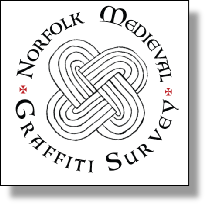










Whilst it is hardly surprising to find crosses inscribed into churches what is remarkable is where they are found. Almost 80% of all the cross inscriptions are not actually located within the main body of the church, but around the entrance doorway and most usually, if there is one, in the porch. These can vary from elaborate and deeply incised crosses to mere scratches on the surface. Often they appear in clusters, or in small groups and doorways such as that at Ludham or Colkirk can have as many as a dozen of these inscriptions.
Although traditionally thought to have been created by people as they went off on pilgrimage, or as thanksgiving for a safe return, there appears to be no evidence for such an interpretation, it only arising in recent centuries. It appears far more likely that these inscriptions are related to the former use that the church porch was put to in the middle ages. Although today the porch is usually little more than a place to hang the church notice board this wasn’t the case in the past. The porch had an important function, with a number of ceremonies, such as marriage and the ‘churching of women’, partly taking place there. The porch also functioned as a parish office, with agreements and contracts being drawn up and witnessed there. It is possible that these crosses are related to transactions or agreements that were carried out in the porch, and were made as a result.










